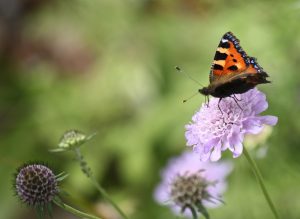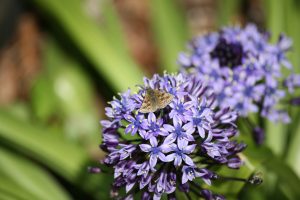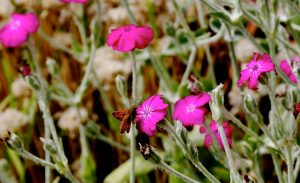The darkest days of the year find me in limbo land, because the garden’s largely hibernating. There are snowdrop tips everywhere, a promise of things to come. The witch hazel buds hang in the air, like tiny fists in snuff-brown gloves, but soon their marmalade strands will break free and flow. For now, I’m reduced to thinking about last year and planning for next. The seed catalogues are fully of tempting things, but I garden for wildlife so I go for flowers with an affinity to wildlife. I want to see butterflies on the wing and I want to hear the soothing buzz of the bee, so soporific on a warm day. I can almost nod off at the very thought.
I am hoping that next year’s summer won’t be as hot and dry, because I grow a great number of things from seed. Last year most of them did very badly. They shrivelled in the heat, due to the dry conditions. The nasturtiums only managed to produce spindly flowers in late-October, not July, and the only annual that really did well was love-lies-bleeding, Amaranthus caudatus. I’ve only just pulled it up!
Chiltern Seeds are my preferred supplier, because the packets are fuller than many and they keep their prices just below the big boys. They sell attractive varieties and their seeds germinate. These days the global seed industry tends to produce seed crops in warmer climates. The same thing is sold across the globe and some will thrive in my cold, cold Cotswold village.
I can safely flick through the Zinnia section, because I’ve tried and failed too often. The best ones I’ve ever seen were in the cutting garden of Chenonceau, a chateau in the warmth of the Loire Valley. These were sturdy four-foot-high plants, full of double jewel-box flowers, and they formed a veritable forest. I could have wept tears of frustration.
I’m concentrating on hardier fellows and one of the best is the scabious, a pincushion of tiny nectar-filled flowers surrounded by a fancy ruff of petals. These attract hoverflies, bees and butterflies because the nectar at the base of each small flower is easily reached. I grow two perennial forms. Scabiosa ochroleuca has dainty lemon-yellow flowers on long wiry stems and it is often one of the last plants in flower. I also grow a pale-blue with slightly larger flowers, S. columbaria, commonly called the small scabious. This performs from late summer onwards. They’re both magnets for pollinators and easily raised from seed collecte din the garden.
Scabiosa atropurpurea is not very hardy, although plants do come through some winters. I treat it as an annual though. I’m particularly fond of ‘Salmon Queen’, because the pink flowers, more raspberry than salmon, have a ruff of wavy petals surrounding a tight middle. It was probably named by a colour-blind chap, because it’s not salmon-pink. This is a good thing, because this shade hovers between pink and orange and it’s extremely difficult to place.
‘Salmon Queen’ has long stems, which is an advantage when cutting, but not as great in the garden. Chiltern Seeds also supply ‘Black Knight’ an almost black tipped in white stamens, and ‘Beaujolais Bonnets’, a deep-pink with a wine-red middle. Scabious cut beautifully and last in the garden as long as they are deadheaded. When August comes, leave some flowers to form oval seeds and then collect and store them for next year.

Our native field scabious Knautia arvensis, the once common wildflower of verges, is gradually disappearing probably due to mowing regimes. More and more verges get cut these days. Field scabious seeds are dispersed by ants bent on licking off the sticky surface of the seeds. They roll them a few metres at most and that limits the spread of the plant. Cyclamen seeds are also dispersed by ants and they never seem to pop up where you want them. The process is known as myrmecochory. I grow clumps of field scabious in my garden borders, because they produce pale-blue flowers by MayIt sets off the yellow daisies of Anthemis E.C. Buxton and acrid-yellow domes of Achillea ‘Moonshine’. I rip it out by the handful when it’s finished its first flush and it reappears and flowers again in autumn. Seedlings are rare.
I’m also growing taller African marigolds with single orange-red flowers because they attract hoverflies. These gyrating flies look very like bees and most of them appear on warm days. Many are migrants, wafted here on a warm breeze. They produce maggot-like white larvae and these feed on aphids and whitefly, so they help the gardener out. The pregnant females seek out colonies of aphids and lay one oval white egg in the midst of a colony. Once the larva hatches out it gets busy, before pupating close to a pollen source.
Most hoverflies found in gardens are beneficial and the adults pollinate plants and their larvae control pests. Hoverflies are attracted to orange, so simply shaped calendulas such as ‘Indian Prince’ and single African marigolds like ‘Burning Embers’ sustain them. They also look right in vegetable and herb gardens and I always surround my runner beans with taller African marigolds. The slugs will go on these, rather than on my runner beans.
Hoverflies have tiny mouthparts, so they also like cow-parsley like plants known as umbels. I have been growing Orlaya grandiflora, the white lace flower, for many a year. However, the warmer weather seems to be making this far more thuggish. It’s a good self-seeder, in a well-drained place, but I have a whole trug of seeds. Gardening friends have suggested I do some guerrilla gardening round the Cotswold lanes.

Once summer really arrives certain plants become bee and butterfly magnets, because they exude sugar-rich nectar that’s far more concentrated. The flowers of Mediterranean plants with aromatic foliage are highly sought after by butterflies and bees in August for this reason. They light up the garden when it’s lacklustre. O. laevigatum ‘Herrenhausen produces a mat of dark foliage and willowy sprays of long-lasting two-tone purple and cool-pink flowers. Small tortoiseshells forage on the nectar and, as the flowers fade, they form delicate seedheads. It would make my Top Ten any day.
The compact form of marjoram, O. vulgare ‘Compactum’ grows in the stone terrace in the full glare of sun. If there are any small copper butterflies about, you’ll find them there, although this year we saw most of ours in autumn. Nepeta is also aromatic, but it’s visited by bumblebees and I rarely see a butterfly. Look out for ‘Hill Grounds’, a slightly prostrate catmint with downy grey-green foliage and bright-blue flowers, and the lavender-blue haze known as ‘Summer Magic’. They’re relatively new and both are being micro-propped for garden centres and nurseries so they’re available in numbers.

I always find room for an easily-grown, silver-leafed perennial named Lychnis coronaria. The bright-pink saucers are on branching stems and seeds produce extra plants. It’s always popular with skippers, who bask on the flowers with their hinged wings. Small heath butterflies, athletic tiny fast movers, also like it. I have also photographed a dingy skipper on a Scilla peruviana flower one a May day. This butterfly feeds on Bird’s-foot Trefoil, Horseshoe Vetch, Buttercup and Hawkweeds and these grow in our mini meadow.

I’ll also be sowing cosmos because it’s so easy to grow, whatever the weather, and it flowers late into the year. I tend to sow my seeds straight into modular trays full of seed-sowing compost. The 28-cell ones work well and it’s best to water them first before you sow. If the seeds are large enough to handle, place two in each full module and very lightly cover. If the seeds ate tinier and more dust-like put the tiniest pinch into each module. Keep the trays damp, rather than wet, and keep them in the trays until the roots have filled the modules. Then pot them up into 3-inch plastic pots containing young seed compost. Don’t fill the pots completely, leave a half inch gap. This technique saves hours of back-breaking pricking out.
I won’t embark on seed sowing until the worst of the winter is over. When it is, I’ll immerse myself in my Hartley greenhouse and dream of butterflies and bees on warm days.



